Reissner–Nordström and Kerr-like Solutions in Finsler–Randers Gravity
Abstract
1. Introduction
2. Geometrical Structure of the Models
- F is continuous on and smooth on , i.e., the tangent bundle minus the null set .
- F is positively homogeneous of first degree on its second argument:
- The formdefines a nondegenerate matrix:
2.1. Linear Connection, Curvature, and Torsion
- The –connection is metric compatible;
- The coefficients , and depend solely on the quantities , , and ;
- The coefficients and are symmetric on the lower indices, i.e., .
2.2. Field Equations
2.3. The Finsler–Randers Metric
2.4. Reissner–Nordström and Kerr Metrics
3. Finsler–Randers–Reissner–Nordström Spacetime
- Timelike: along the curve;
- Lightlike: along the curve;
- Spacelike: along the curve.
4. A Kerr-like Approach for a Finsler–Randers Spacetime
4.1. Solution of the Field Equations
4.2. Geodesics in the Kerr F-R Spacetime
4.3. Quasinormal Modes of Background Fields
5. Conclusions
Author Contributions
Funding
Data Availability Statement
Acknowledgments
Conflicts of Interest
Abbreviations
| F-R | Finsler–Randers |
| R-N | Reissner–Nordström |
| FRRN | Finsler–Randers–Reissner–Nordström |
Appendix A
References
- Saridakis, E.N.; Lazkoz, R.; Salzano, V.; Moniz, P.V.; Capozziello, S.; Jiménez, J.B.; De Laurentis, M.; Olmo, G.J. Modified Gravity and Cosmology: An Update by the CANTATA Network; Springer: Berlin/Heidelberg, Germany, 2021. [Google Scholar]
- Di Valentino, E.; Levi Said, J.; Riess, A.; Pollo, A.; Poulin, V.; Gómez-Valent, A.; Weltman, A.; Palmese, A.; Huang, C.D.; van de Bruck, C.; et al. The CosmoVerse White Paper: Addressing observational tensions in cosmology with systematics and fundamental physics. arXiv 2025, arXiv:2504.01669. [Google Scholar] [CrossRef]
- Shao, Y.; Moon, S.; Rudenko, A.N.; Wang, J.; Herzog-Arbeitman, J.; Ozerov, M.; Graf, D.; Sun, Z.; Queiroz, R.; Lee, S.H.; et al. Semi-Dirac fermions in a topological metal. Phys. Rev. X 2024, 14, 041057. [Google Scholar] [CrossRef]
- Shamir, L. The distribution of galaxy rotation in JWST Advanced Deep Extragalactic Survey. Mon. Not. R. Astron. Soc. 2025, 538, 76–91. [Google Scholar] [CrossRef]
- Misner, C.W.; Thorne, K.S.; Wheeler, J.A. Gravitation; Princeton University Press: Princeton, NJ, USA, 2017; ISBN 978-0-691-17779-3. [Google Scholar]
- Campanelli, L.; Cea, P.; Fogli, G.; Tedesco, L. Cosmic parallax in ellipsoidal universe. Mod. Phys. Lett. A 2011, 26, 1169–1181. [Google Scholar] [CrossRef]
- Campanelli, L.; Cea, P.; Tedesco, L. Ellipsoidal universe can solve the cosmic microwave background quadrupole problem. Phys. Rev. Lett. 2006, 97, 131302. [Google Scholar] [CrossRef]
- Campanelli, L.; Cea, P.; Tedesco, L. Cosmic microwave background quadrupole and ellipsoidal universe. Phys. Rev. D 2007, 76, 063007. [Google Scholar] [CrossRef]
- Migkas, K.; Pacaud, F.; Schellenberger, G.; Erler, J.; Nguyen-Dang, N.T.; Reiprich, T.H.; Ramos-Ceja, M.E.; Lovisari, L. Cosmological implications of the anisotropy of ten galaxy cluster scaling relations. Astron. Astrophys. 2021, 649, A151. [Google Scholar] [CrossRef]
- Pandya, A.; Migkas, K.; Reiprich, T.H.; Stanford, A.; Pacaud, F.; Schellenberger, G.; Lovisari, L.; Ramos-Ceja, M.E.; Nguyen-Dang, N.T.; Park, S. Examining the local Universe isotropy with galaxy cluster velocity dispersion scaling relations. Astron. Astrophys. 2021, 691, A355. [Google Scholar] [CrossRef]
- Tedesco, L. Ellipsoidal Universe and Cosmic Shear. Universe 2024, 10, 363. [Google Scholar] [CrossRef]
- Triantafyllopoulos, A.; Basilakos, S.; Kapsabelis, E.; Stavrinos, P.C. Schwarzschild-like solutions in Finsler-Randers gravity. Eur. Phys. J. C 2020, 80, 1200. [Google Scholar] [CrossRef]
- Kapsabelis, E.; Triantafyllopoulos, A.; Basilakos, S.; Stavrinos, P.C. Applications of the Schwarzschild-Finsler-Randers model. Eur. Phys. J. C 2021, 81, 990. [Google Scholar] [CrossRef]
- Stavrinos, P.; Diakogiannis, F. Finslerian Structure of Anisotropic Gravitational Field. Gravit. Cosmol. 2004, 10, 269–278. [Google Scholar]
- Vacaru, S.; Stavrinos, P.; Gabourov, E.; Gontsa, D. Clifford and Riemann-Finsler Structures in Geometric Mechanics and Gravity. arXiv 2005, arXiv:gr-qc/0508023. [Google Scholar] [CrossRef]
- Kouretsis, A.P.; Stathakopoulos, M.; Stavrinos, P.C. The General Very Special Relativity in Finsler Cosmology. Phys. Rev. D 2009, 79, 104011. [Google Scholar] [CrossRef]
- Skakala, J.; Visser, M. Bi-metric pseudo-Finslerian spacetimes. J. Geom. Phys. 2011, 61, 1396–1400. [Google Scholar] [CrossRef]
- Kostelecky, A. Riemann-Finsler geometry and Lorentz-violating kinematics. Phys. Lett. B 2011, 701, 137–143. [Google Scholar] [CrossRef]
- Vacaru, S.I. Principles of Einstein-Finsler Gravity and Perspectives in Modern Cosmology. Int. J. Mod. Phys. D 2012, 21, 1250072. [Google Scholar] [CrossRef]
- Pfeifer, C.; Wohlfarth, M.N.R. Finsler geometric extension of Einstein gravity. Phys. Rev. D 2012, 85, 064009. [Google Scholar] [CrossRef]
- Basilakos, S.; Kouretsis, A.P.; Saridakis, E.N.; Stavrinos, P. Resembling dark energy and modified gravity with Finsler-Randers cosmology. Phys. Rev. D 2013, 88, 123510. [Google Scholar] [CrossRef]
- Pfeifer, C.; Wohlfarth, M.N.R. Causal structure and electrodynamics on Finsler spacetimes. Phys. Rev. D 2011, 84, 044039. [Google Scholar] [CrossRef]
- Elizalde, E.; Vacaru, S.I. Einstein spaces modeling nonminimal modified gravity theories. Eur. Phys. J. Plus 2015, 130, 119. [Google Scholar] [CrossRef]
- Caponio, E.; Stancarone, G. Standard static Finsler spacetimes. Int. J. Geom. Methods Mod. Phys. 2016, 30, 1650040. [Google Scholar] [CrossRef]
- Brody, D.C.; Gibbons, G.W.; Meier, D.M. A Riemannian approach to Randers geodesics. J. Geom. Phys. 2016, 106, 98–101. [Google Scholar] [CrossRef]
- Hohmann, M.; Pfeifer, C. Geodesics and the magnitude-redshift relation in general Finsler spacetimes. Phys. Rev. D 2017, 95, 104021. [Google Scholar] [CrossRef]
- Wang, D.; Meng, X.-H. Seeking sterile neutrinos in Finslerian cosmology. Eur. Phys. J. C 2017, 77, 725. [Google Scholar] [CrossRef]
- Ellis, J.; Mavromatos, N.E.; Nanopoulos, D.V. Novel foamy origin for singlet fermion masses. Phys. Rev. D 2017, 96, 086012. [Google Scholar] [CrossRef]
- Silva, J.E.G. Symmetries and fields in Randers-Finsler spacetime. arXiv 2016, arXiv:1602.07345. [Google Scholar] [CrossRef]
- Wang, D.; Meng, X.-H. Finslerian universe may reconcile tensions between high and low redshift probes. arXiv 2017, arXiv:1709.04141. [Google Scholar] [CrossRef]
- Shah, M.B.; Ganai, P.A. Quantum gauge freedom in Lorentz violating background: A Finsler geometry approach. Int. J. Geom. Methods Mod. Phys. 2018, 15, 1850009. [Google Scholar] [CrossRef]
- Fuster, A.; Pabst, C.; Pfeifer, C. Berwald spacetimes and very special relativity. Phys. Rev. D 2018, 98, 084062. [Google Scholar] [CrossRef]
- Triantafyllopoulos, A.; Stavrinos, P.C. Weak field equations and generalized FRW cosmology on the tangent Lorentz bundle. Class. Quantum Grav. 2018, 35, 085011. [Google Scholar] [CrossRef]
- Chaubey, R.; Tiwari, B.; Shukla, A.K.; Kumar, M. Finsler–Randers Cosmological Models in Modified Gravity Theories. Proc. Natl. Acad. Sci. India Sec. A Phys. Sci. 2019, 89, 757–768. [Google Scholar] [CrossRef]
- Minas, G.; Saridakis, E.N.; Stavrinos, P.C.; Triantafyllopoulos, A. Bounce cosmology in generalized modified gravities. Universe 2019, 5, 74. [Google Scholar] [CrossRef]
- Bubuianu, L.; Vacaru, S.I. Black holes with modified dispersion relations and solitonic configurations in Einstein-Finsler gravity. Ann. Phys. 2019, 404, 10–38. [Google Scholar] [CrossRef]
- Ikeda, S.; Saridakis, E.N.; Stavrinos, P.C.; Triantafyllopoulos, A. Cosmology of Lorentz fiber-bundle induced scalar-tensor theories. Phys. Rev. D 2019, 100, 124035. [Google Scholar] [CrossRef]
- Hohmann, M.; Pfeifer, C.; Voicu, N. Cosmological Finsler Spacetimes. Universe 2020, 6, 65. [Google Scholar] [CrossRef]
- Caponio, E.; Masiello, A. On the Analyticity of Static Solutions of a Field Equation in Finsler Gravity. Universe 2020, 6, 59. [Google Scholar] [CrossRef]
- Relancio, J.J.; Liberati, S. Phenomenological consequences of a geometry in the cotangent bundle. Phys. Rev. D 2020, 101, 064062. [Google Scholar] [CrossRef]
- Hohmann, M.; Pfeifer, C.; Voicu, N. The kinetic gas universe. Eur. Phys. J. C 2020, 80, 809. [Google Scholar] [CrossRef]
- Hohmann, M.; Pfeifer, C.; Voicu, N. Relativistic kinetic gases as direct sources of gravity. Phys. Rev. D 2020, 101, 024062. [Google Scholar] [CrossRef]
- Javaloyes, M.Á.; Sánchez, M.; Villaseñor, F.F. The Einstein-Hilbert-Palatini formalism in pseudo-Finsler geometry. Adv. Theor. Math. Phys. 2022, 26, 10. [Google Scholar] [CrossRef]
- Konitopoulos, S.; Saridakis, E.N.; Stavrinos, P.C.; Triantafyllopoulos, A. Dark gravitational sectors on a generalized scalar-tensor vector bundle model and cosmological applications. Phys. Rev. D 2021, 104, 064018. [Google Scholar] [CrossRef]
- van Voorthuizen, J. Kasner Metric in Finsler Gravity. Bachelor’s Thesis, Eindhoven University of Technology, Eindhoven, The Netherlands, 2021. [Google Scholar]
- Hama, R.; Harko, T.; Sabau, S.V.; Shahidi, S. Cosmological evolution and dark energy in osculating Barthel-Randers geometry. Eur. Phys. J. C 2021, 81, 742. [Google Scholar] [CrossRef]
- Hama, R.; Harko, T.; Sabau, S.V. Dark energy and accelerating cosmological evolution from osculating Barthel-Kropina geometry. Eur. Phys. J. C 2022, 82, 385. [Google Scholar] [CrossRef]
- Hama, R.; Harko, T.; Sabau, S.V. Conformal gravitational theories in Barthel-Kropina-type Finslerian geometry, and their cosmological implications. Eur. Phys. J. C 2023, 83, 1030. [Google Scholar] [CrossRef]
- Heefer, S.; Pfeifer, C.; Reggio, A.; Fuster, A. A Cosmological unicorn solution to Finsler gravity. Phys. Rev. D 2023, 108, 064051. [Google Scholar] [CrossRef]
- Narasimhamurthy, S.K.; Praveen, J. Cosmological constant roll of inflation within Finsler-barthel-Kropina geometry: A geometric approach to early universe dynamics. New Astron. 2024, 108, 102187. [Google Scholar] [CrossRef]
- Friedl-Szász, A.; Popovici-Popescu, E.; Voicu, N.; Pfeifer, C.; Heefer, S. Cosmological Landsberg-Finsler spacetimes. Phys. Rev. D 2025, 111, 044058. [Google Scholar] [CrossRef]
- Zhu, J.; Ma, B.-Q. Lorentz violation in Finsler geometry. Symmetry 2023, 15, 978. [Google Scholar] [CrossRef]
- Savvopoulos, C.; Stavrinos, P.C. Anisotropic conformal dark gravity on the Lorentz tangent bundle spacetime. Phys. Rev. D 2023, 108, 044048. [Google Scholar] [CrossRef]
- Fernández Villaseñor, F. Lorentz-Finsler Geometry and Einstein Equations. Ph.D. Thesis, University of Granada (Joint with U’s of Almería, Cádiz, Jaén and Málaga), Granada, Spain, 2024. [Google Scholar]
- Randers, G. On an Asymmetrical Metric in the Four-Space of General Relativity. Phys. Rev. 1941, 59, 195. [Google Scholar] [CrossRef]
- Gibbons, G.W.; Gomis, J.; Pope, C.N. General very special relativity is Finsler geometry. Phys. Rev. D 2007, 76, 081701. [Google Scholar] [CrossRef]
- Raushan, R.; Chaubey, R. Finsler-Randers cosmology in the framework of a particle creation mechanism: A dynamical systems perspective. Eur. Phys. J. Plus 2020, 135, 228. [Google Scholar] [CrossRef]
- Mavromatos, N.E. Violation of CPT invariance in the Early Universe: Strings in a Robertson-Walker background and particle-antiparticle asymmetries. J. Phys. Conf. Ser. 2013, 447, 012016. [Google Scholar] [CrossRef]
- Vacaru, S.I. Exact solutions in modified massive gravity and off-diagonal wormhole deformations. Eur. Phys. J. C 2014, 74, 2781. [Google Scholar] [CrossRef]
- Vacaru, S.I.; Irwin, K. Off-diagonal deformations of Kerr metrics and black ellipsoids in heterotic supergravity. Eur. Phys. J. C 2017, 77, 17. [Google Scholar] [CrossRef]
- Caponio, E.; Stancarone, G. On Finsler spacetimes with a timelike Killing vector field. Class. Quantum Grav. 2018, 35, 085007. [Google Scholar] [CrossRef]
- Stavrinos, P.C.; Alexiou, M. Raychaudhuri equation in the Finsler-Randers space-time and generalized scalar-tensor theories. Int. J. Geom. Methods Mod. Phys. 2018, 15, 1850039. [Google Scholar] [CrossRef]
- Heefer, S.; Pfeifer, C.; Fuster, A. Randers pp-waves. Phys. Rev. D 2021, 104, 024007. [Google Scholar] [CrossRef]
- Elbistan, M.; Zhang, P.M.; Dimakis, N.; Gibbons, G.W.; Horvathy, P.A. Geodesic motion in Bogoslovsky-Finsler spacetimes. Phys. Rev. D 2020, 102, 024014. [Google Scholar] [CrossRef]
- Silva, J.E.G. A field theory in Randers-Finsler spacetime. Europhys. Lett. 2021, 133, 21002. [Google Scholar] [CrossRef]
- Angit, S.; Raushan, R.; Chaubey, R. Stability and bifurcation analysis of Finsler-Randers cosmological model. Pramana 2022, 96, 123. [Google Scholar] [CrossRef]
- Lou, H.; Li, J.; Yang, W.; Feng, W.; Liu, W.; Zhang, Q.; Zhang, N.; Qi, Y.; Wu, Y. Theoretical analysis on the Rényi holographic dark energy in the Finsler-Randers cosmology. Int. J. Mod. Phys. D 2022, 31, 2250002. [Google Scholar] [CrossRef]
- Kapsabelis, E.; Kevrekidis, P.G.; Stavrinos, P.C.; Triantafyllopoulos, A. Schwarzschild-Finsler-Randers spacetime: Geodesics, dynamical analysis and deflection angle. Eur. Phys. J. C 2022, 82, 1908. [Google Scholar] [CrossRef]
- El-Nabulsi, A.R.; Golmankhaneh, A.K. Nonstandard and fractal electrodynamics in Finsler-Randers space. Int. J. Geom. Methods Mod. Phys. 2022, 19, 2250080. [Google Scholar] [CrossRef]
- Voicu, N.; Friedl-Szász, A.; Popovici-Popescu, E.; Pfeifer, C. The Finsler spacetime condition for (α,β)-metrics and their isometries. Universe 2023, 9, 198. [Google Scholar] [CrossRef]
- Feng, W.; Lou, H.; Li, X. Theoretical analysis on the Barrow holographic dark energy in the Finsler-Randers cosmology. Int. J. Mod. Phys. D 2023, 32, 2350029. [Google Scholar] [CrossRef]
- Das, K.P.; Debnath, U. Possible existence of traversable wormhole in Finsler-Randers geometry. Eur. Phys. J. C 2023, 83, 821. [Google Scholar] [CrossRef]
- Kapsabelis, E.; Saridakis, E.N.; Stavrinos, P.C. Finsler-Randers-Sasaki gravity and cosmology. Eur. Phys. J. C 2024, 84, 538. [Google Scholar] [CrossRef]
- Chanda, S. More on Jacobi metric: Randers-Finsler metrics, frame dragging and geometrisation techniques. Eur. Phys. J. Plus 2024, 139, 983. [Google Scholar] [CrossRef]
- Stavrinos, P.C.; Kouretsis, A.P.; Stathakopoulos, M. Friedman-like Robertson-Walker model in generalized metric space-time with weak anisotropy. Gen. Relativ. Gravit. 2008, 40, 1403–1425. [Google Scholar] [CrossRef]
- Silagadze, Z.K. On the Finslerian extension of the Schwarzschild metric. Acta Phys. Polon. B 2010, 41, 2171–2176. [Google Scholar] [CrossRef]
- Li, X.; Zhao, S.-P. Quasinormal modes in Finslerian-Schwarzschild spacetime. Phys. Rev. D 2020, 101, 124012. [Google Scholar] [CrossRef]
- He, K.-J.; Yao, J.-T.; Zhang, X.; Li, X. Shadows and photon motions in axially symmetric Finslerian Schwarzschild black holes. Phys. Rev. D 2024, 109, 064049. [Google Scholar] [CrossRef]
- Dehkordi, H.R.; Richartz, M.; Saa, A. Finslerian structure of black holes. arXiv 2025, arXiv:2501.09536. [Google Scholar] [CrossRef]
- Yao, J.-T.; Zhu, Q.-H.; Li, X. Identifying axially symmetric Finslerian extensions of Schwarzschild black hole via the S2 star orbiting Sagittarius A★. Phys. Rev. D 2025, 111, 084083. [Google Scholar] [CrossRef]
- Kerr, R.P. Gravitational field of a spinning mass as an example of algebraically special metrics. Phys. Rev. Lett. 1963, 11, 237–238. [Google Scholar] [CrossRef]
- Konoplya, R.A.; Zhidenko, A. Stability and quasinormal modes of the massive scalar field around Kerr black holes. Phys. Rev. D 2006, 73, 124040. [Google Scholar] [CrossRef]
- Rajpoot, S.; Vacaru, S.I. Black Ring and Kerr Ellipsoid—Solitonic Configurations in Modified Finsler Gravity. Int. J. Geom. Methods Mod. Phys. 2015, 12, 1550102. [Google Scholar] [CrossRef]
- Li, X. Special Finslerian generalization of the Reissner-Nordström spacetime. Phys. Rev. D 2018, 98, 084030. [Google Scholar] [CrossRef]
- Rarras, D.; Kosmas, T.; Papavasileiou, T.; Kosmas, O. Galactic Stellar Black Hole Binaries: Spin Effects on Jet Emissions of High-Energy Gamma-Rays. Particles 2024, 7, 792–804. [Google Scholar] [CrossRef]
- Kerr, R.P.; Debney, G.C. Einstein spaces with symmetry groups. J. Math. Phys. 1970, 11, 2807–2812. [Google Scholar] [CrossRef]
- Visser, M. The Kerr spacetime: A brief introduction. arXiv 2007, arXiv:0706.0622. [Google Scholar] [CrossRef]
- Cvetič, M.; Gibbons, G.W. Exact quasinormal modes for the near horizon Kerr metric. Phys. Rev. D 2014, 89, 064057. [Google Scholar] [CrossRef]
- Kerr, R.P. Do Black Holes have Singularities? arXiv 2023, arXiv:2312.00841. [Google Scholar] [CrossRef]
- Miron, R.; Anastasiei, M. The Geometry of Lagrange Spaces: Theory and Applications. In Fundamental Theories of Physics; Springer: Heidelberg, The Netherlands, 1994. [Google Scholar] [CrossRef]
- Rarras, D.; Kosmas, O.; Papavasileiou, T.; Kosmas, T. Black Hole’s Spin-Dependence of γ-Ray and Neutrino Emissions from MAXI J1820+070, XTE J1550-564, and XTE J1859+226. Particles 2024, 7, 818–833. [Google Scholar] [CrossRef]
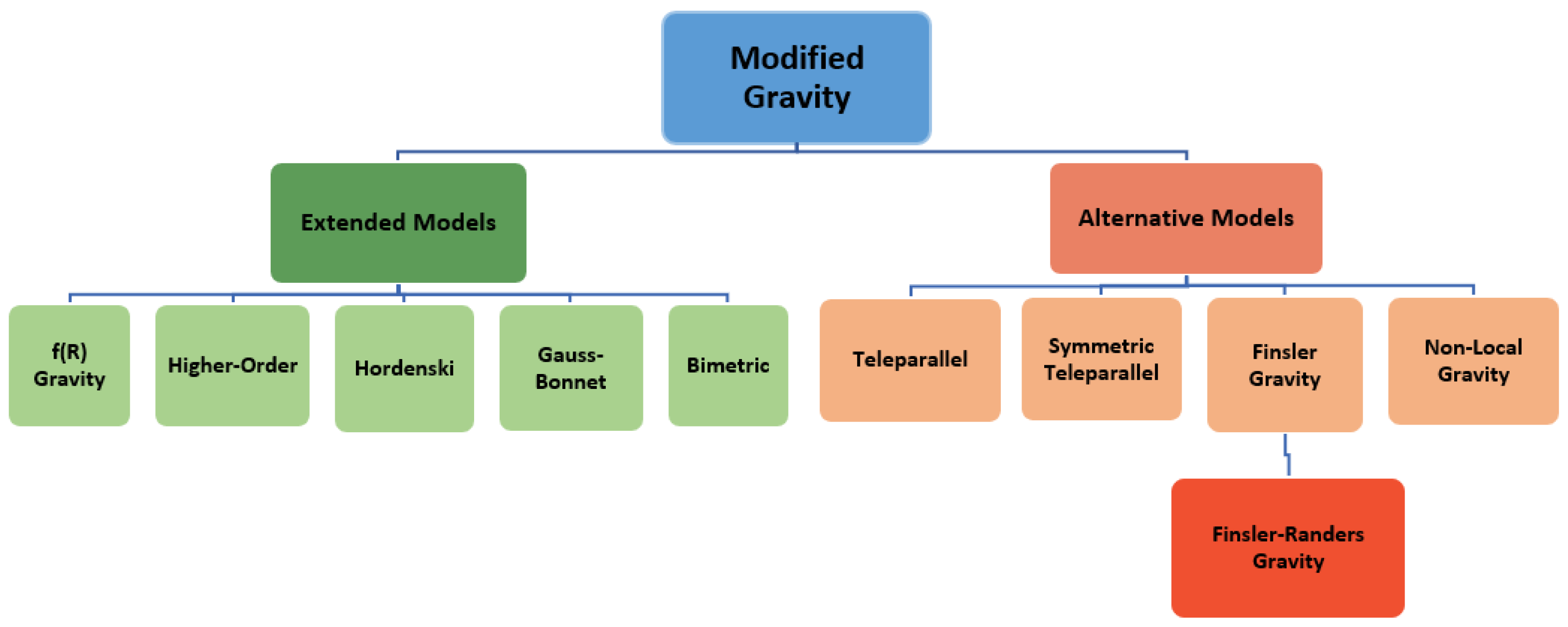

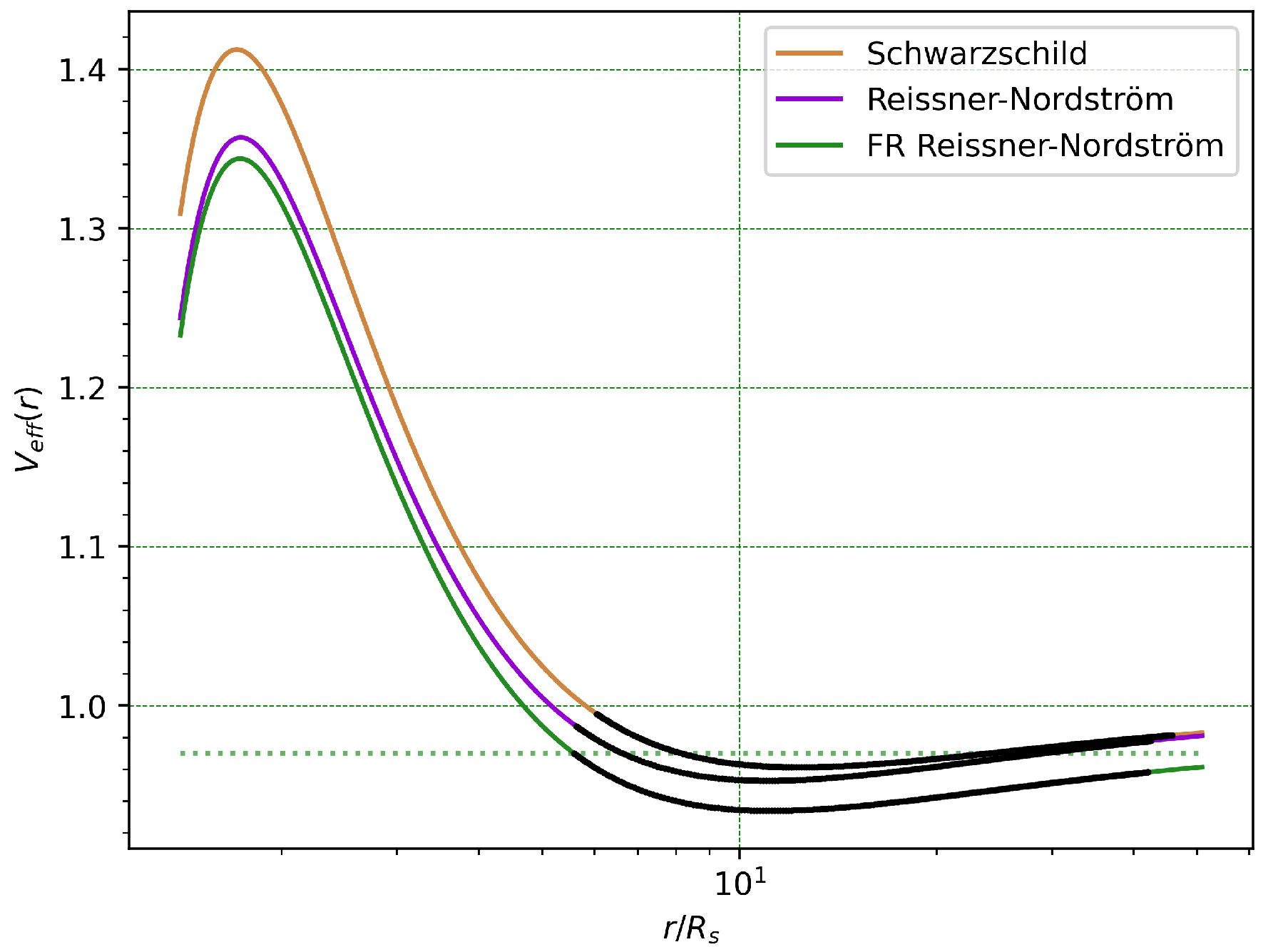
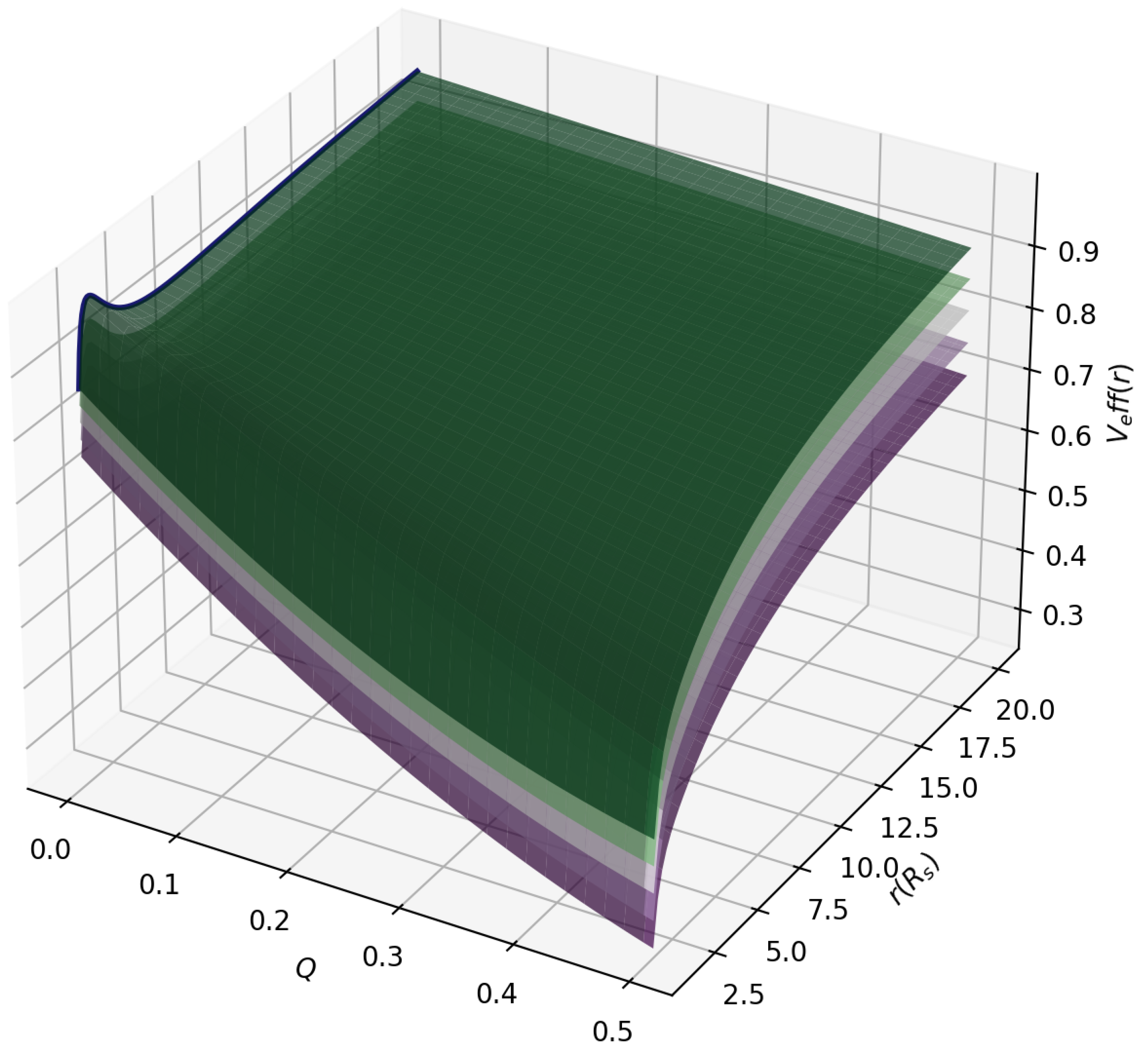
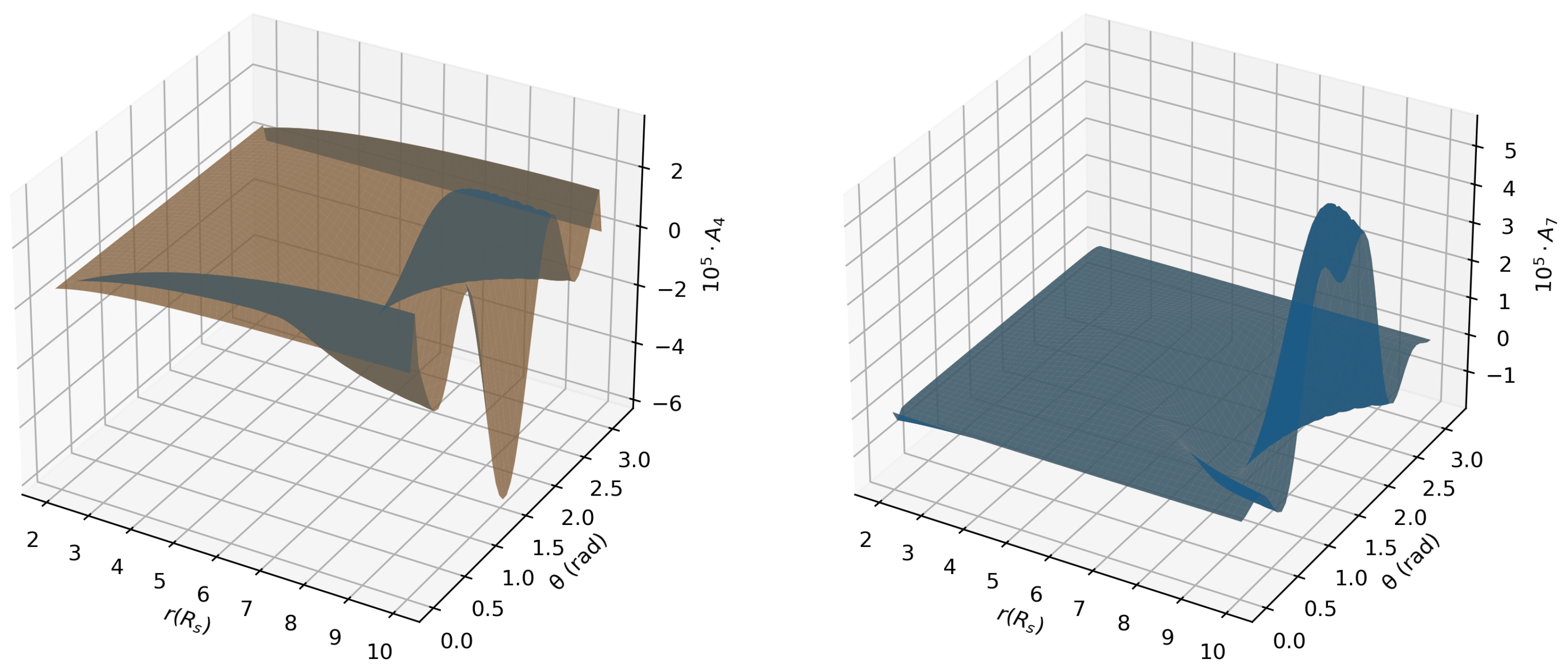
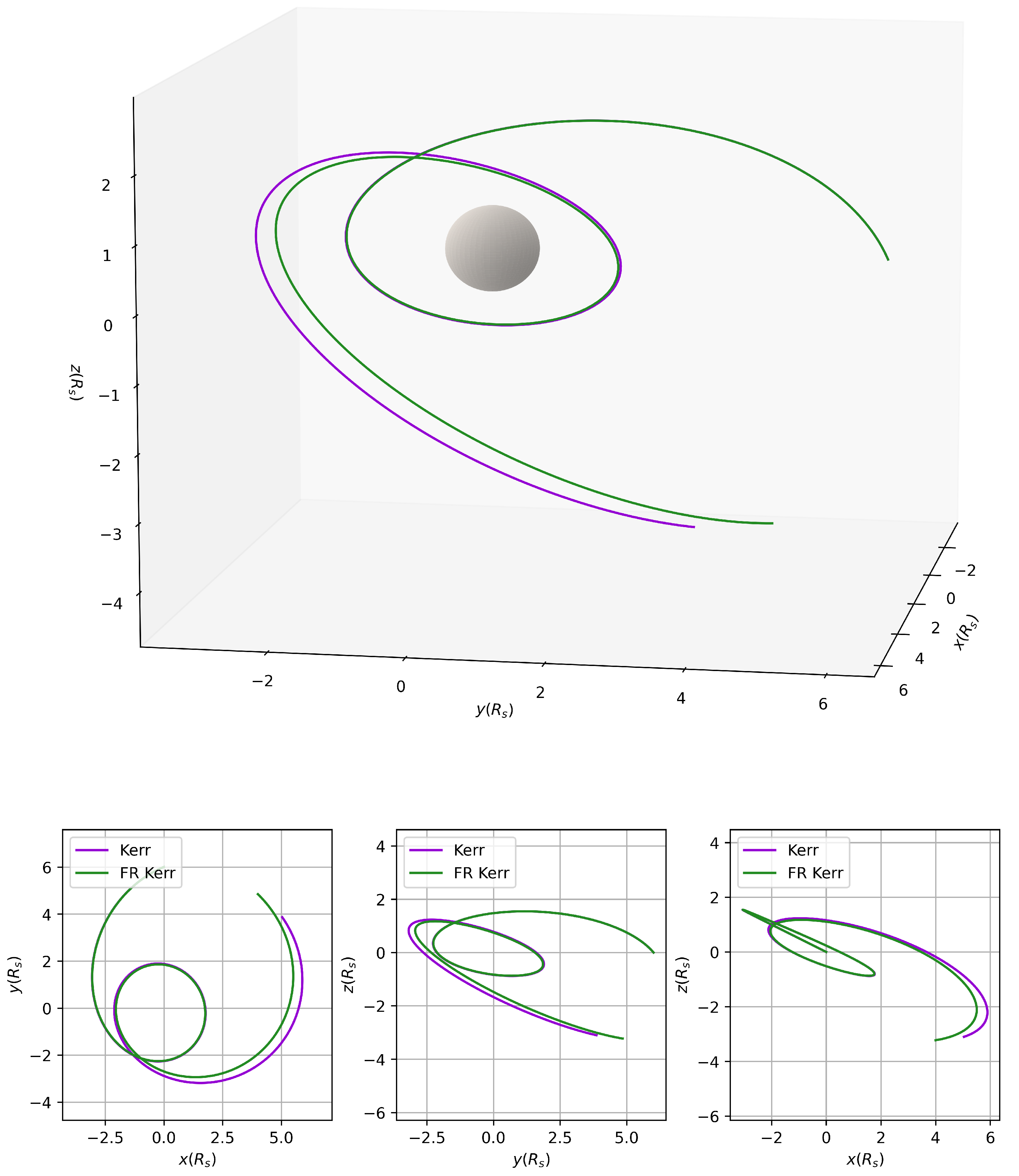
Disclaimer/Publisher’s Note: The statements, opinions and data contained in all publications are solely those of the individual author(s) and contributor(s) and not of MDPI and/or the editor(s). MDPI and/or the editor(s) disclaim responsibility for any injury to people or property resulting from any ideas, methods, instructions or products referred to in the content. |
© 2025 by the authors. Licensee MDPI, Basel, Switzerland. This article is an open access article distributed under the terms and conditions of the Creative Commons Attribution (CC BY) license (https://creativecommons.org/licenses/by/4.0/).
Share and Cite
Miliaresis, G.; Topaloglou, K.; Ampazis, I.; Androulaki, N.; Kapsabelis, E.; Saridakis, E.N.; Stavrinos, P.C.; Triantafyllopoulos, A. Reissner–Nordström and Kerr-like Solutions in Finsler–Randers Gravity. Universe 2025, 11, 201. https://doi.org/10.3390/universe11070201
Miliaresis G, Topaloglou K, Ampazis I, Androulaki N, Kapsabelis E, Saridakis EN, Stavrinos PC, Triantafyllopoulos A. Reissner–Nordström and Kerr-like Solutions in Finsler–Randers Gravity. Universe. 2025; 11(7):201. https://doi.org/10.3390/universe11070201
Chicago/Turabian StyleMiliaresis, Georgios, Konstantinos Topaloglou, Ioannis Ampazis, Nefeli Androulaki, Emmanuel Kapsabelis, Emmanuel N. Saridakis, Panayiotis C. Stavrinos, and Alkiviadis Triantafyllopoulos. 2025. "Reissner–Nordström and Kerr-like Solutions in Finsler–Randers Gravity" Universe 11, no. 7: 201. https://doi.org/10.3390/universe11070201
APA StyleMiliaresis, G., Topaloglou, K., Ampazis, I., Androulaki, N., Kapsabelis, E., Saridakis, E. N., Stavrinos, P. C., & Triantafyllopoulos, A. (2025). Reissner–Nordström and Kerr-like Solutions in Finsler–Randers Gravity. Universe, 11(7), 201. https://doi.org/10.3390/universe11070201








